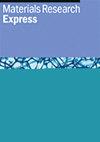Microstructure and mechanical properties of TiC reinforced NbC-Ni4VC4Mo2C cermets
IF 2.2
4区 材料科学
Q3 MATERIALS SCIENCE, MULTIDISCIPLINARY
引用次数: 0
Abstract
The class of NbC-Ni cermets has emerged as a promising environmentally friendly alternative to WC-Co cemented carbide tools, although some inherent properties i.e. room temperature hardness and flexural strength, of NbC-Ni cermets may require further enhancements. To enhance the properties of NbC-Ni cermets, diverse methodologies were applied, including grain inhibition and the strengthening of the cermet through the use of reinforcements. This study systematically examined the impact of TiC additions, specifically at 10% and 20%, on both the microstructure and mechanical properties of NbC-12Ni-4VC-4Mo2C cermets. NbC-12Ni cermets were fabricated via vacuum liquid phase sintering (LPS) at 1400 °C and 1450 °C. Enhancements by incorporating 4% VC and 4% Mo2C, followed by TiC at 10% and 20% concentrations to the NbC-Ni-4VC4Mo2C cermet were made. XRD and SEM results confirm the formation of (Nb, X, Y) C solid solution cubic FCC carbides. Significant grain refinement was evident in the cermet samples, subjected to grain inhibition. The observed grain sizes ranged from a maximum of 6.84 μm (in NbC12Ni) to a minimum of 2.154 μm (in the sample containing 20% TiC) at 1450 °C. The incorporation of 20TiC at 1450 °C led to a remarkable 26.5% enhancement in average hardness compared to NbC-Ni cermet, and a 4.2% improvement over the 4VC4Mo2C cermet. At 1450 °C, 20TiC reinforcement led to an average fracture toughness of 9.331 MPa√m, representing a 4.56% improvement over the 4VC4Mo2C cermet. However, there was a marginal reduction in toughness compared to the NbC-Ni cermet. Moreover, the addition of TiC led to a decrease in the flexural strength of the cermets, with a maximum flexural strength of 939 N mm−2 recorded for NbC-Ni-4VC4Mo2C, representing an 11.6% increase compared to the NbC-Ni cermet.TiC 增强 NbC-Ni4VC4Mo2C 金属陶瓷的微观结构和力学性能
尽管 NbC-Ni 金属陶瓷的某些固有特性(如室温硬度和抗弯强度)可能需要进一步提高,但该类金属陶瓷已成为一种很有前途的环保型工具,可替代 WC-Co 硬质合金工具。为了提高 NbC-Ni 金属陶瓷的性能,人们采用了多种方法,包括晶粒抑制和通过使用增强材料来强化金属陶瓷。本研究系统地考察了 TiC 添加量(特别是 10% 和 20%)对 NbC-12Ni-4VC-4Mo2C 金属陶瓷微观结构和机械性能的影响。NbC-12Ni 金属陶瓷是在 1400 °C 和 1450 °C 下通过真空液相烧结 (LPS) 制成的。通过在 NbC-Ni-4VC4Mo2C 金属陶瓷中加入 4% 的 VC 和 4% 的 Mo2C,再加入 10% 和 20% 的 TiC,该金属陶瓷得到了增强。XRD 和 SEM 结果证实了 (Nb, X, Y) C 固溶体立方 FCC 碳化物的形成。在受到晶粒抑制的金属陶瓷样品中,晶粒明显细化。在 1450 °C 时,观察到的晶粒大小从最大 6.84 μm(在 NbC12Ni 中)到最小 2.154 μm(在含 20% TiC 的样品中)不等。与 NbC-Ni 金属陶瓷相比,在 1450 ℃ 时加入 20TiC 使平均硬度显著提高了 26.5%,与 4VC4Mo2C 金属陶瓷相比提高了 4.2%。1450 °C 时,20TiC 增强材料的平均断裂韧性为 9.331 MPa√m,比 4VC4Mo2C 金属陶瓷提高了 4.56%。不过,与 NbC-Ni 金属陶瓷相比,韧性略有降低。此外,添加 TiC 会导致金属陶瓷的抗弯强度降低,NbC-Ni-4VC4Mo2C 的最大抗弯强度为 939 N mm-2,与 NbC-Ni 金属陶瓷相比提高了 11.6%。
本文章由计算机程序翻译,如有差异,请以英文原文为准。
求助全文
约1分钟内获得全文
求助全文
来源期刊

Materials Research Express
MATERIALS SCIENCE, MULTIDISCIPLINARY-
CiteScore
4.50
自引率
4.30%
发文量
640
审稿时长
12 weeks
期刊介绍:
A broad, rapid peer-review journal publishing new experimental and theoretical research on the design, fabrication, properties and applications of all classes of materials.
 求助内容:
求助内容: 应助结果提醒方式:
应助结果提醒方式:


